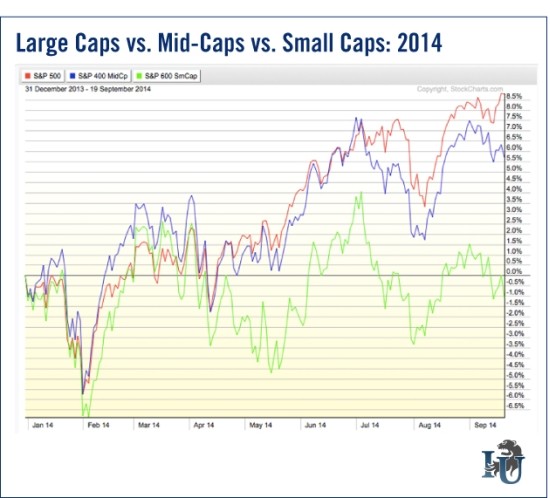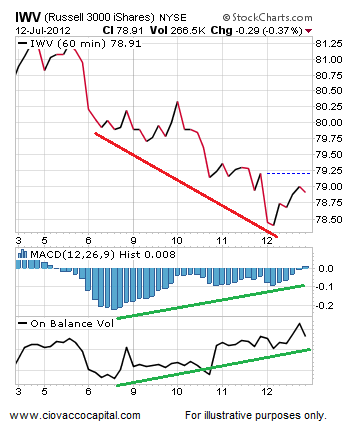My Investment Worries The Dollar LargeCap Stocks Treasuries and ETFs
Post on: 12 Июль, 2015 No Comment

Essentially, investment risk is not a number. The price of risk failure is the forgoing of important funding plans. In that light, your risk is not the same as my risk — not only because we have different financial and personal resources but also because we have different time frames.
No matter the planning time horizon of a portfolio, there is another major difference between two similar portfolios. In this age of optimization, many portfolios protect funding out of resources with little to spare for unexpected mistakes. For many, there are no reserves for mistakes because the investor or his or her manager has supposedly identified all possible disruptions. Thus, they have created an expectation risk, and therefore, they need to examine what could go badly wrong with their expectations.
I suggest the biggest impact of an expectation risk is likely to be found in the very assets that most investors have the highest level of confidence in. Not only am I a contrarian by nature; I am also a student of history who gets uncomfortable when there is excessive enthusiasm. My current worry list is as follows:
- The US dollar Large-cap stocks Treasuries, US and some others Exchange-traded funds (ETFs) and other market structure changes
These worries are not generally recognized in market prices, but I think they should be. Therefore, I perceive significant market price distortions that don’t recognize that in the future something could go wrong in most portfolios.
Part of my worries is that few if any professional investors are publicly concerned about the concerns that are on my list.
The (Mighty) US Dollar
For those of us who live in a competitive price environment, we are very much aware of the price spread for similar, usually not truly identical, items. There are always reasons why the bulk of buyers and sellers can identify with the current price (e.g. availability, ease of transaction, easy to service, and other qualities of merit). As an entrepreneur, I always wanted to be the high-priced service sold to discriminating, great capital sources. My approach was that my successful pricing was a badge of high quality. I was conscious that this policy was holding up an umbrella over cheaper competition, but in the institutional world, quality usually trumps price, within reason.
Turning to the current valuation of the US dollar, the widening price spread versus all other major currencies suggests to me a leaky umbrella. Our current exalted position is not due to our virtuous qualities of protecting the purchasing power of our currency, but rather, it is due to the perceived decline in value of other currencies. Some of the weaknesses in other currencies are self-imposed by the deliberate mercantile policies of governments to help sales of their exports to the United States. In a period of increasingly unpopular governments within their countries and with their neighbors, people are choosing to store some of their wealth in the United States, behind its supposed two-ocean fortress sitting on valuable natural and human resources. Because the US monetary leadership is having enough trouble attempting to manage the domestic economy and a current Washington political establishment that would like to isolate the United States from others’ problems, there is no desire to establish the US dollar as the single world currency. Thus, at some future point, an unannounced but real weaker US dollar policy is likely.
In the future, various economies will start growing again and become attractive places for investment by both the locals and those from outside. Therefore, it would be wise to hedge one’s longer-term portfolio against continued dollar strength. A number of mutual fund investors have been doing this for some time. With the exception of the five trading days ending December 24, traditional US mutual fund investors have been adding to their non-domestic holdings while redeeming some of their domestic fund holdings. (The latter move could very well be a normal pattern of mutual fund investors exiting for retirement and other needs. In most cases, the domestic funds are the oldest of their holdings.)
The Leaky Large-Cap House
If the US dollar is being held up by a potentially leaky umbrella, the investment houses holding large caps may start to leak soon. We acknowledged in last week’s post that in general, large-cap mutual funds in 2014 performed materially better than smaller-market-capitalization funds. At present and historically, there is no solid evidence that large-cap companies will do better than smaller caps. The foreword of Charley Ellis’s book What It Takes states that “None of the ten largest corporations in the U.S. economy in 1900 still ranked in the top ten 50 years later, and, indeed, only three actually survived as companies.” Further to this point, JP Morgan Asset Management notes that since 1980, the S&P 500 Index has dropped 320 stocks, or roughly 10 per year, due to mergers, low volume, and an inversion of their tax headquarters. The problems that caused these results were more widespread, with numerous large companies losing their advantage. Some possible victims of these deteriorations today might well be General Motors, IBM, and Citigroup, among others.
Turning to the large-cap stocks as distinct from the companies themselves, there are significant changes occurring. First, the surge of stock price performance above the level of earnings progress may well be a warehouse effect. In the past when investment managers were concerned about not being invested in a market that was gently rising to flat before a perceived decline, they hid from their clients by investing in stocks of very large companies. AT&T was the best of the warehouses, with its predictable $9.00 dividend, which hadn’t changed for about 40 years. Today, many of the tactical players have shifted to using ETFs. In the week ending Christmas Eve, approximately $1 billion flowed into two S&P 500 ETFs (net of their redemptions) out of $23.7 billion. Some of the inflows could be covering shorts. As of December 15, the SPDR S&P 500 ETF had the second largest short position, 240 million shares. (The largest was our old warehouse name but applied to a different company, AT&T.) More on the changing market structure through ETFs and other derivatives below.
The current market sentiment may well be changing from complacency to belief in a general recovery starting in the United States and haltingly going global. One clue that this could happen would be if in 2015 small-market-capitalization stocks once again perform better than larger caps. We could even see some flows from the larger caps into smaller-cap funds. Due to ETF players that are mostly faster-trading institutions, we could see redemptions in various index funds as sentiment shifts from avoiding losses to picking exploding winners.
Treasuries Discipline
Surprisingly, the US deficit is declining, in part owing to the sequester in 2013, but it is still a deficit that does not include the off-balance-sheet liabilities for various government programs. We have not pledged to produce surpluses to retire our debt except in times of war. One also needs to recognize our twin infrastructures in terms of roads and bridges as well as our growing educational deficit. We are not alone in our lack of discipline; most other countries are similarly addicted to deficit spending. For those of us who can choose to not invest in various governments’ securities, this lack of discipline is an additional imponderable. However, for our banking institutions, it should be a considerable issue because banks in most countries must own local government paper. Often the various authorities treat government paper more favorably than commercial paper in terms of the level of reserves required. Thus, to some extent, our whole financial system is exposed to the level of discipline applied to our Treasury deficit machine.

ETFs and Other Market Structure Changes
Students of warfare often note that changes of weaponry change how battles are fought and won. Clearly, the introduction of the English longbow and military aircraft are two examples. In the investment marketplace battles, some rely on the most current weapon, which is often not fully tested. The 1987 market fall is a good example of a market collapse that was not tightly tied to an economic collapse. In a somewhat overpriced market after a multiyear rising market, many institutional investors felt secure because of their newly acquired weapon of “portfolio insurance.” This procedure was based on locked-in trades of securities and derivatives largely executed in Chicago. When markets were functioning normally with other investors using the various tactics of the past, a limited amount of portfolio insurance transactions apparently worked. However, as the decline accelerated, many institutions and some trading organizations withdrew from the market, so the locked-in derivatives trades were working against each other in driving prices into a free fall.
In 2014, the popularity of derivatives — particularly ETFs — grew, and now, they often represent the bulk of trading in an emotional period.
To put the size of the power of ETFs into perspective, the following points are worth noting:
- While the estimated net inflow into traditional US mutual funds for the week ending Christmas Eve was $12.8 billion (the highest since March 2000), almost twice as much ($23.7 billion net) came in through ETFs. As BlackRock’s Larry Fink has been warning for some time, institutions are using ETFs, instead of futures, to speculate. There are roughly 250 authorized participants in the creation and redemption of ETFs. In many, if not most, cases, these participants are acting for institutional clients. Some of the participants’ purchases may be to aid in setting up short positions or providing securities to meet share-lending requirements. To put the importance of the shorting of ETF shares in perspective, as of December 15, 7 of the largest 40 short positions on New York Stock Exchange stocks were ETFs. As of the same day, 9 of the 30 largest changes in short positions were for ETFs. Because of particular interest in the S&P Biotech ETF, the short position would take 17 days to cover. The use of derivatives in both fixed-income and currency trading is extensive. Some regulators and I are wondering whether several of these new weapons will blow up certain users and possible counterparties in the heat of battle.
How Does One Live with the Worries?
One must recognize that there probably has never been or never will be a period without worries. Long-term investors need to be both flexible and diversified. In our four TimeSpan L Portfolios structure, I suggest that the Operational Portfolio (one to two years) stay tactical and not take large losses. In the Replenishment Portfolio (two to five years), one should develop tactics that can tolerate at least one or two poor years. The Endowment Portfolio (5–10+ years) should shift to a more strategic view to take advantage of periodic declines. The Legacy Portfolio, needed to feed multiple future generations, has a need to separate current fashionable thinking from expected future changes.
If you liked this post, consider subscribing to the Enterprising Investor .
Please note that the content of this site should not be construed as investment advice, nor do the opinions expressed necessarily reflect the views of CFA Institute.
Photo credit: ©iStockphoto.com/dane_mark














